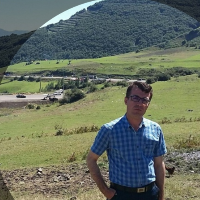Analysis the relationship between the changes of hydrological components and landscape metrics under rainfall simulation and rangeland vegetation of Ardabil Province
The rainfall system of a major part of Iran is mediterranean, where the precipitation amount during the vegetation period is low. In addition, the occurrence of precipitation in the non-vegetation period or beginning of the vegetation period, which does not cover the surface of the earth well, is one of the important reasons for water erosion in Iran. Since vegetation has a special role in soil erosion control and runoff retention, any change in the vegetation structure and pattern, which expresses the landscape pattern and function, can have a significant effect on changing hydrological processes. Therefore, the assessment of soil and water loss and the quantification of its relationship with landscape metrics provide key information for the development of water and soil quality management strategies.
The current research was conducted to investigate the hydrological component changes with landscape metrics on 2 m2 plots using simulated rainfall at an intensity of 32 mm.h-1 in a part of rangelands of Ardabil County. At first, considering the type and percentage of vegetation as the main variable, eight groups of vegetation composition along with one group without vegetation (control) were considered with three replications. The composition (and percentage) of the vegetation from the first to the eighth groups, respectively, include low-height graminea predominance (45), the composition of dense bushes with graminea (43), bushes with low-height and medium-distribution (37), sparse bushes mostly with low and medium height (31), the composition of sparse bushes with graminea (56), dense bushes in upper parts (54), low-height bushes with very low distribution (15), and dense bushes with almost uniform distribution (56). After measuring the runoff and sediment at the plot outlets, different hydrological components were calculated. Then, plots with nine different vegetation combinations were imaged in three replicates before and after rainfall simulation. After transferring the images prepared from the plots to the Arc/Map10.8 environment, nine important landscape metrics were calculated.
Changes in the mean patch density (4.43-26.90), largest patch index (54.16-86.75), edge density (17.12-107.38), landscape shape index (1.50-4.47), mean shape area (4.16-37.46), mean Euclidean nearest neighbor distance (0.00-1.65), landscape division index (0.19-2.31), mean patch shape index (1.24-22.85), and the effective mesh size (15.80-43.96) indicate their different influence from different percentage and composition of vegetation cover. Spearman's correlation matrix analysis showed a nonsignificant relationship between the mean soil loss, runoff volume, runoff coefficient, and sediment concentration with landscape metrics (r<0.26 and p-value>0.10). The small scale of the studied plots, the lack of diversity in the vegetation composition, and the uniformity in terms of vegetation height can be cited as the reasons for the lack of correlation. In general, groups with vegetation values above 50% had a better condition in terms of LPI, AREA_MN, and MESH, which indicates more connectivity and less degradation. The increase in vegetation cover and spatial heterogeneity above the landscape surface can change the path of sediment transport, reduce sediment connectivity, and lead to a decrease in sedimentation.
The obtained results are applicable in explaining the appropriate reference to optimize water and soil protection measures on the watershed scale. However, It is suggested that similar and more comprehensive research be done in different scales of erosion plots and even in the landscape (slope) scale so that by considering a wide range of vegetation, topography, climatic conditions, as well as successive rains, it is possible to compare the results, optimum selection of study scale, and finally planning to manage and protect vegetation and water and soil resources.
- حق عضویت دریافتی صرف حمایت از نشریات عضو و نگهداری، تکمیل و توسعه مگیران میشود.
- پرداخت حق اشتراک و دانلود مقالات اجازه بازنشر آن در سایر رسانههای چاپی و دیجیتال را به کاربر نمیدهد.






